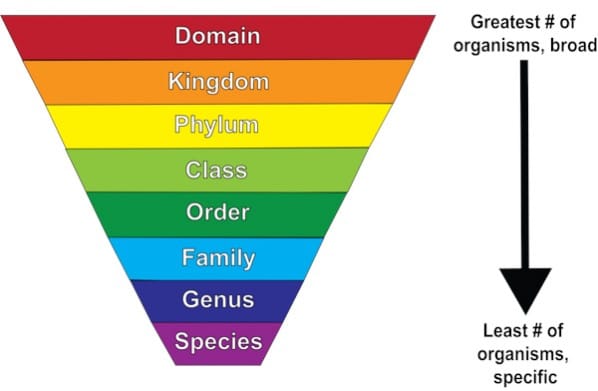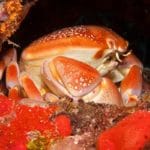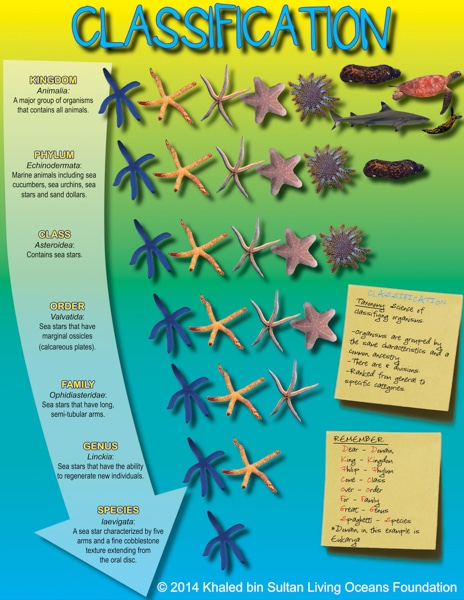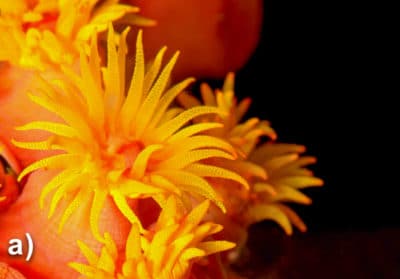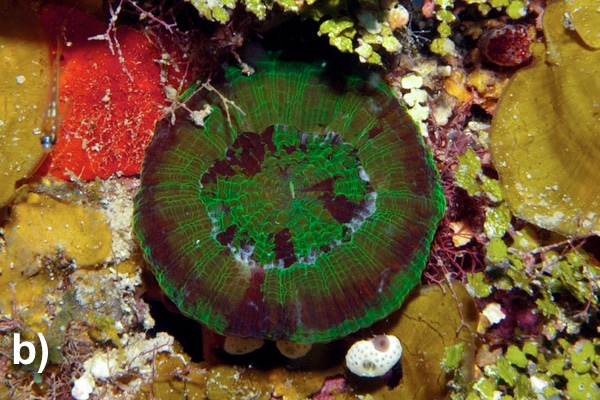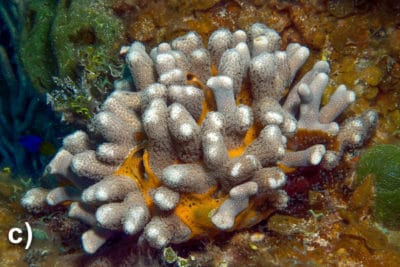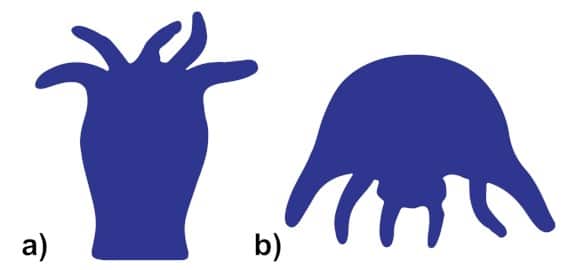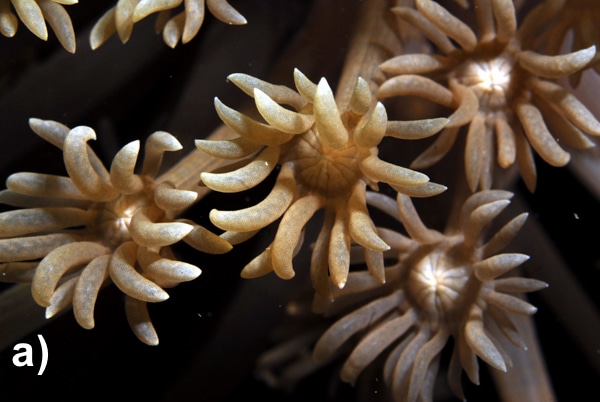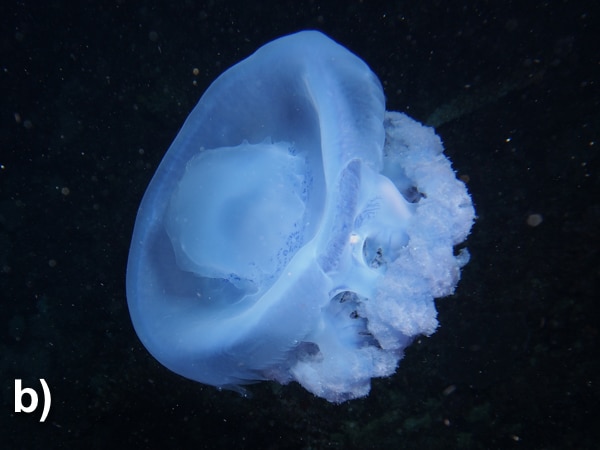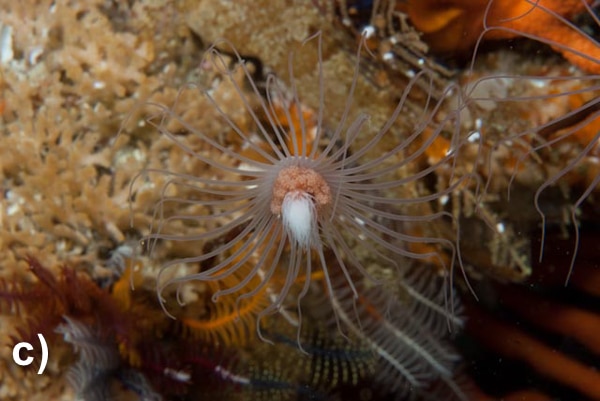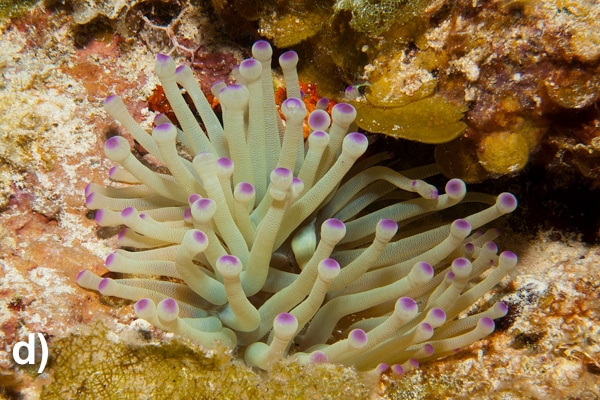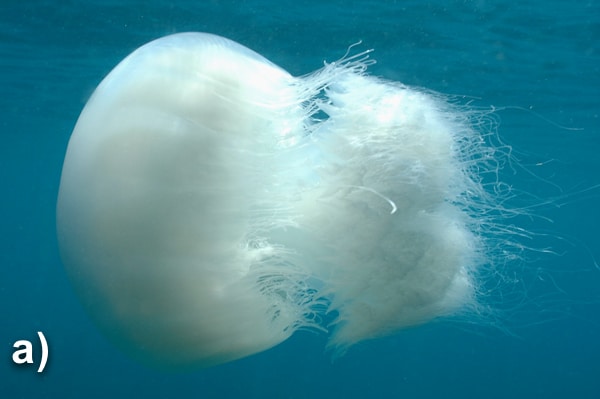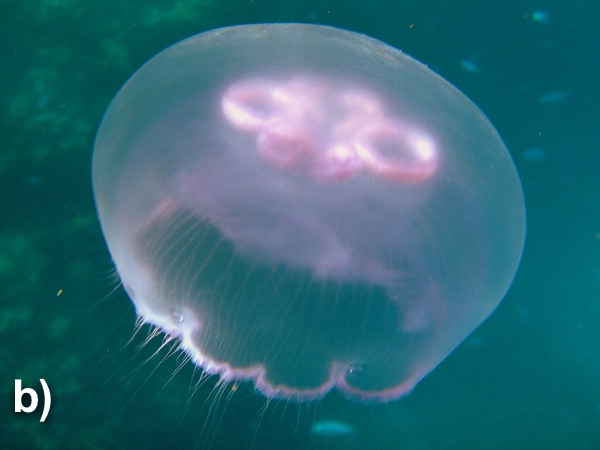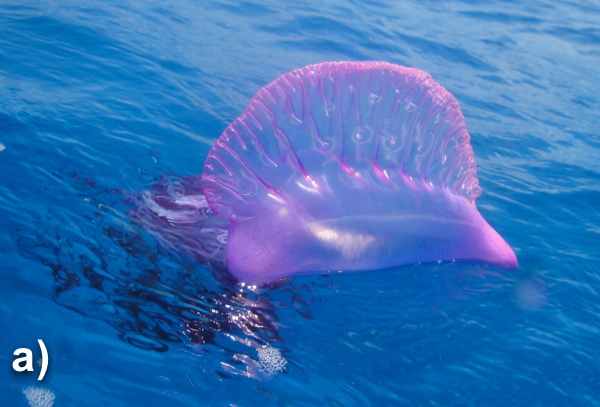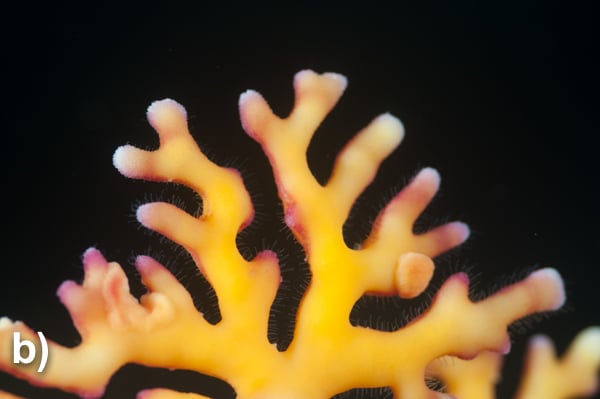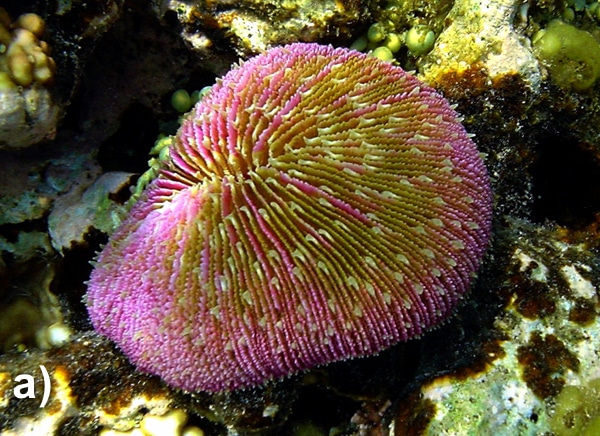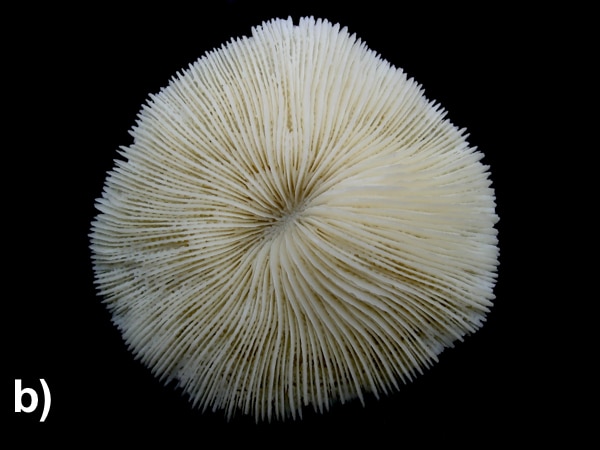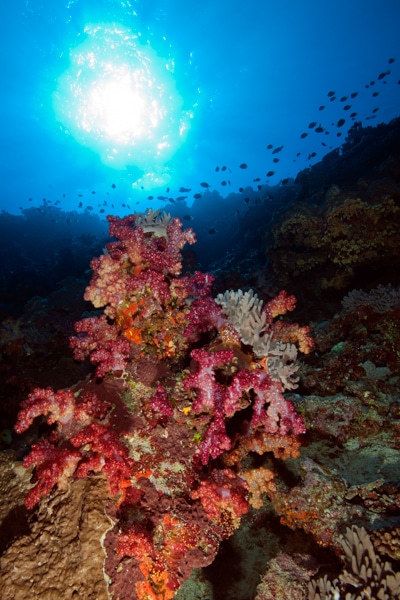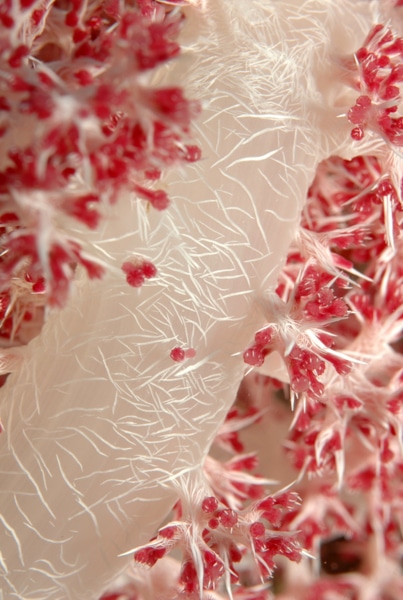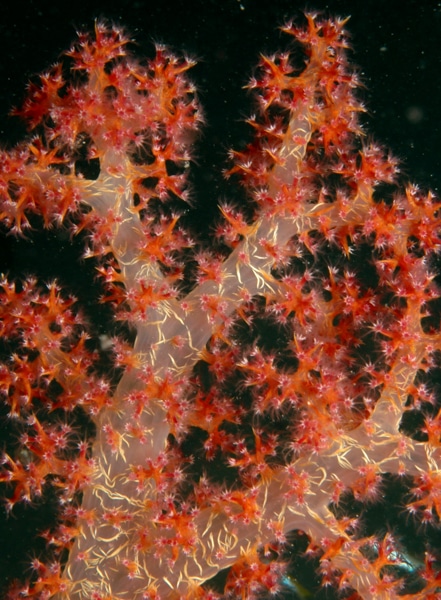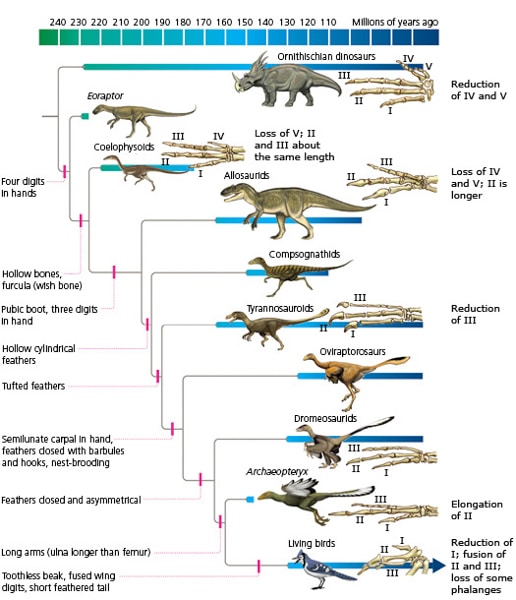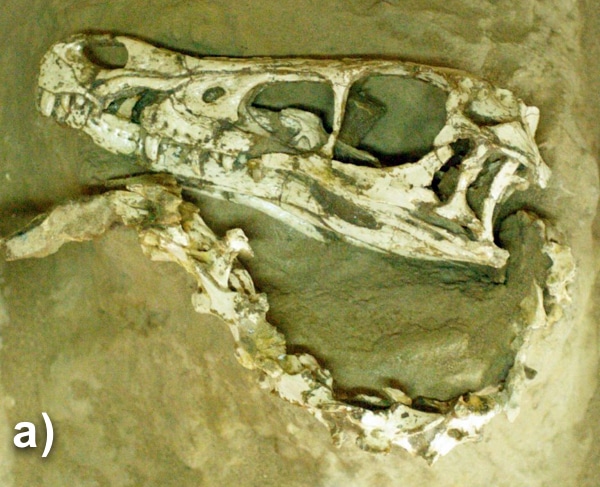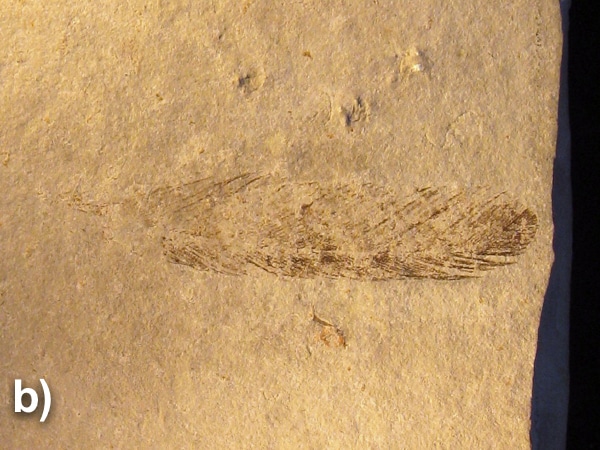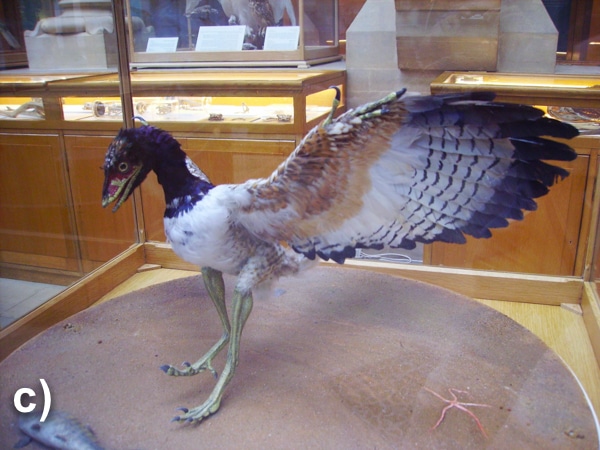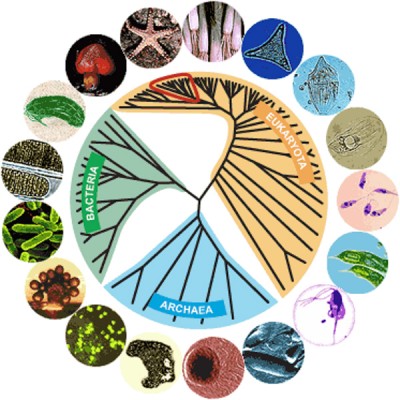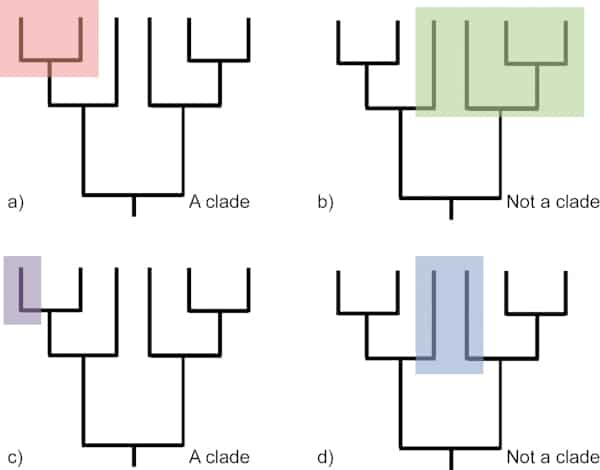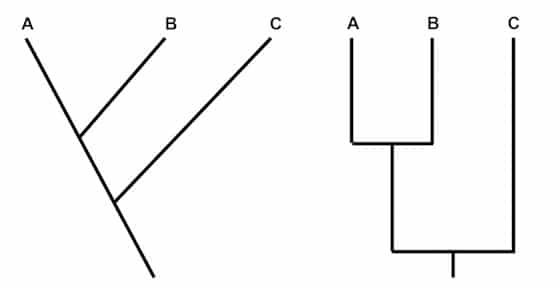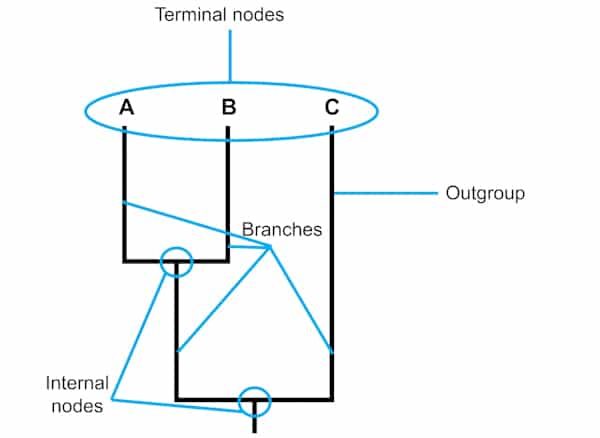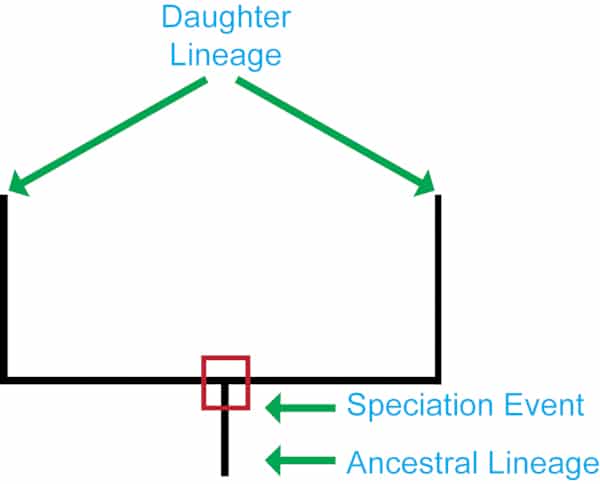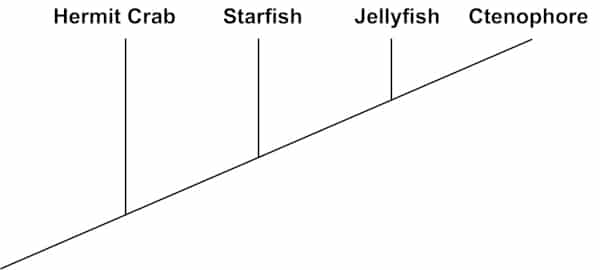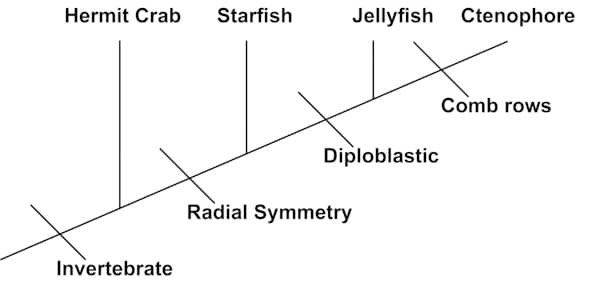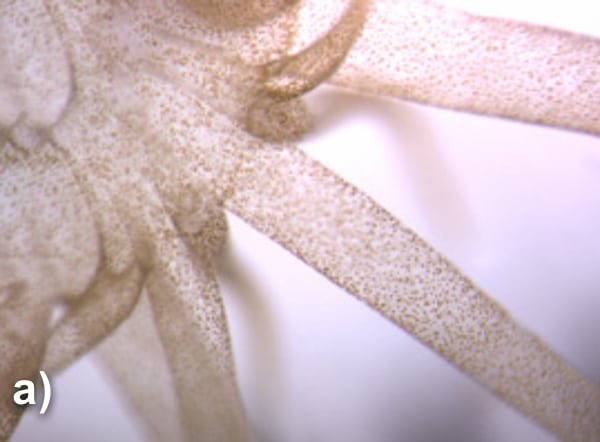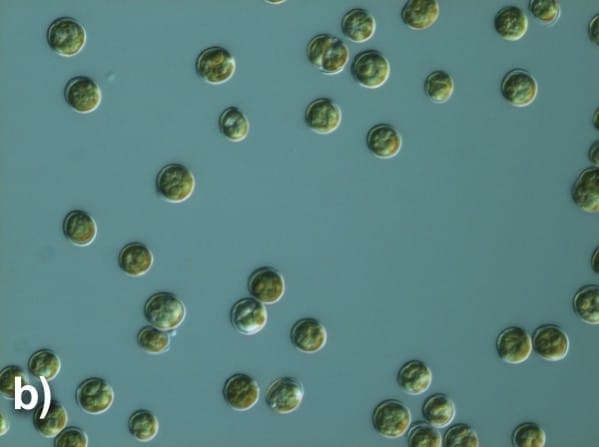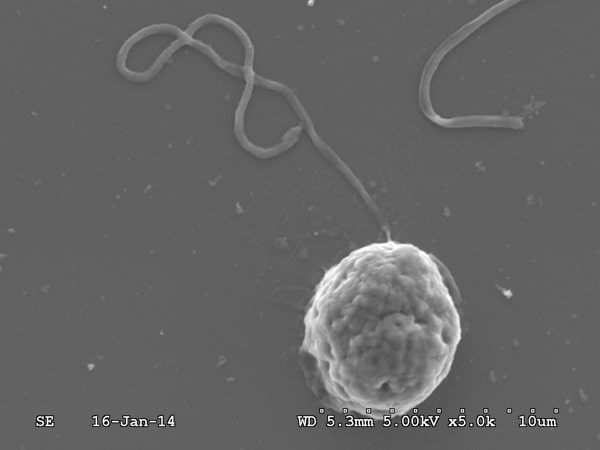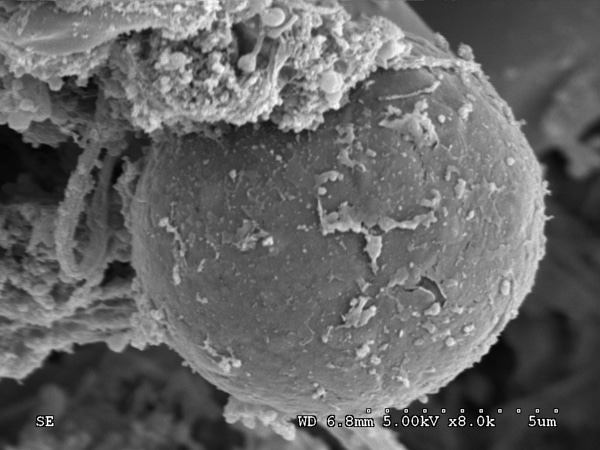Fact Friday
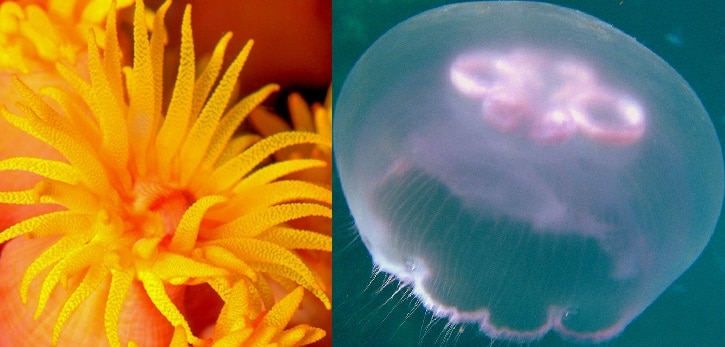
Some cnidarians switch between a polyp and a medusa body form. Corals and anemones only have the polyp stage. Jellyfish, as we think of them, are in the medusa stage, but they have a polyp stage when they are juveniles. Hydrozoans have the opposite: their adult form is a polyp, but they have a juvenile medusa stage.
Photo Credit: KSLOF, Rob Martimbeault
Background Information
HOW DO WE CLASSIFY ORGANISMS?
There are millions of organisms on Earth. In this unit on biological classification, we will learn how to organize them. Scientists classify organisms by putting them into groups that have the same characteristics and a common ancestry. Classification is a broad term that means organizing information. The science of classifying organisms is known as taxonomy. Taxonomy is a type of classification.
There are eight divisions used to classify all life on Earth (figure 2-1):
Figure 2-1. Diagram of the 8 divisions of classification
To help you remember the order of classification, use the mnemonic device:

Dear – Domain
King – Kingdom
Philip – Phylum
Come – Class
Over – Order
For – Family
Great – Genus
Spaghetti – Species
Domain is the broadest division, and as we descend down the list, the divisions get more and more specific. In a domain, there are more organisms; however, as we descend down the list, notice that there are fewer and fewer organisms in each classification. This is best illustrated in figure 2-2. Every known organism is classified by these eight divisions.
Fun fact
X

Fun Fact

The phylum Arthropoda is the largest in the animal kingdom, which includes organisms such as crabs, barnacles, lobsters, mites, ticks, spiders, insects, scorpions, centipedes, and millipedes. The phylum Arthropoda includes more than 80% of all animals. The main characteristics for this phylum include:
- Hard outer exoskeleton, an external skeleton that supports and protects an animal’s body
- Segmented body
- Jointed appendages, external body parts that protrude from an organism’s body (legs, wings, antennae, mouthparts, swimming legs, tails, gills)
To help you remember some of these characteristics look at the word Arthropoda:
Arthro – poda
Arthro- reminds us of the word arthritis. Where do we get arthritis? Our joints. –poda literally translates to foot. Put them together and we get jointed foot or, better put, jointed appendage.
Photo Credit: Ken Mark
Let’s take a look at the following example of organisms in the Domain Eukarya (figure 2-2). Remember that each organism is grouped by the same characteristics and a common ancestry. As we descend down the list, we eliminate organisms that do not fit into that particular division. For example, Phylum Echinodermata contains only sea cucumbers, sea stars, and a few other organisms not pictured; however it does not contain sharks, sea turtles, and sea slugs. Sea turtles and sharks are in the Phylum Chordata because they have a backbone. Nudibranchs are in the Phylum Mollusca because they have soft bodies. Now, let’s look at the Family Ophidiasteridae. Notice that the pink sea star, known as the granular sea star, has short, thick arms. The other sea stars in this family have long semi-tubular arms.
Figure 2-2
All of the organisms in figure 2-2 are classified in the Domain Eukarya, which is made up of organisms that have cells containing complex structures enclosed within membranes like a nucleus. By the time we reach species (specific), only one organism fits the description. The only characteristic that sets the blue sea star, Linckia laevigata, apart from other sea stars is the body pattern. That’s really specific!
LINNAEAN NAMING SYSTEM
The naming system that is used today was first established in the 18th century by a Swedish scientist named Carolus Linnaeus. He was the first to develop a hierarchical naming system, which included kingdom, class, order, genus, species, and variety. The original naming system has since changed; however, this was a huge breakthrough for modern science, which is often why Linnaeus is referred to as the Father of Taxonomy. Additionally, the naming system is sometimes called Linnaean taxonomy.
Fun fact
X

Fun Fact

In 1735, Carolus Linnaeus published his first edition of Systema Naturae. This book was the first to outline a naming system. He published 13 editions in all, adding species and making taxonomic changes to each edition. The first edition only had 11 pages, but by the time he published his final edition, the book had exceeded 3,000 pages. One of his most important changes occurred in the 10th edition when he reclassified whales from fish to mammals. In 1757, Linnaeus was granted nobility for his scientific efforts. To show this noble rank, his name was changed to Carl von Linné – von signified his ennoblement.
Source: Johan Henrik Scheffel [Public domain], 12 September 2005 via Wikimedia Commons. https://commons.wikimedia.org/wiki/File%3ACarl_Linnaeus.jpg.
Linnaean naming system also led to the adoption of modern binomial nomenclature, which means two-name naming system. It is often referred to as the Latin name or scientific name. This is the formal naming of organisms that includes the genus and species name. There are specific rules when writing binomial nomenclature. Let’s follow the rules using the scientific name, Amphiprion ocellaris. You may know this animal to be Nemo, a clownfish, from the movie Finding Nemo. The rules are as follows:
| 1. Genus is written first. | amphiprion |
| 2. Species is written second. | amphiprion ocellaris |
| 3. Genus is always capitalized. | Amphiprion ocellaris |
| 4. Species is never capitalized. | Amphiprion ocellaris |
| 5. Genus and species are both italicized (or underlined). | Amphiprion ocellaris or Amphiprion ocellaris |
| 6. Genus can stand alone, but species never stands alone. Even when genus is alone, it is italicized. | Amphiprion but not |
| 7. When repeating a scientific name in a document: | |
| a. The first time the scientific name is written, use the full name, following the binomial nomenclature rules. | The scientific name for the common clownfish is Amphiprion ocellaris. |
| b. The second time the scientific name is written, abbreviate the genus by using the first letter, capitalize it, and use a period. Then write the species name. The genus abbreviation and species name will be italicized. | The scientific name for the common clownfish is Amphiprion ocellaris. A. ocellaris is the clownfish that Nemo is modeled after in the movie Finding Nemo. |
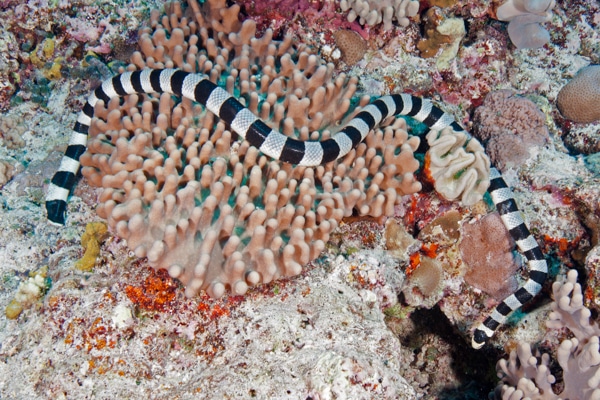
Photo Credit: Ken Marks
Most organisms are also given a simpler name. This name is referred to as the common name or vernacular name. It is used because of the difficulty to memorize scientific names, and it is often used by members of the general public. We have already seen these examples:
- Amphiprion ocellaris, common clownfish
- Linckia laevigata, blue sea star
Sometimes the common name varies depending on geographic locations and cultures. For example, Laticauda colubrina (figure 2-3) has three different common names: colubrine sea krait, banded sea krait, and the yellow-lipped sea krait. That’s why the scientific name is important – it is one name used universally by scientists. No matter the differences in culture, language, or geographic region, everyone can understand the meaning.
CORAL CLASSIFICATION I
There are over 1,000 known coral species all of which live in the ocean. Corals are a member of the Domain Eukarya because they have cells that contain complex structures.
Figure 2-4. a) Tubastrea sp.; b) Scolymia sp.; and c) Porites sp.
Photo Credits: a) KSLOF; b) Ken Marks; c) Ken Marks
Historically, classifying corals at the kingdom level was misunderstood. Scientists used to believe that corals were plants (Kingdom Plantae); however, today we know that they are animals (Kingdom Animalia).
Fun fact
X

Fun Fact

Did you know that corals used to be classified in the vegetable kingdom? In Elements in Natural History by John Stark (1828), he explains how older naturalists used to refer to corals as “stony vegetables” or “vegetating stones.” Today, of course, we know that corals are a part of the animal kingdom.
Source: Stark, J. 1828. Elements of Natural History: Invertebrata. Vegetable kingdom. Mineral kingdom. Edinburgh: Adam Black and John Stark.
Corals are part of the Phylum Cnidaria. Anemones, hydroids, and jellyfish also belong to this phylum. Cnidarians share several common characteristics. NOTE: We will learn more about most of these characteristics in other units.
- Two different forms exist: medusa and polyp (figure 2-5).
- Radially symmetrical (figure 2-8 and 2-9).
- Diploblastic (two cell layers) with mesoglea (Unit 3: Coral Anatomy).
- Body contains an internal cavity (gastrovascular cavity) and a mouth, but no anus. This is called a blind gut (Unit 3: Coral Anatomy).
- Lack excretory, circulatory, and respiratory systems (Unit 3: Coral Anatomy).
- Reproduction is asexual and/or sexual (Unit 5: Reproduction).
- Have simple netlike nervous system.
- Have a distinct larval stage, which is planktonic (Unit 6: Life Cycle).
- Live in aquatic environments, mostly marine.
- Mostly carnivorous, otherwise filter feeders (Unit 4: Feeding).
- May have a minimal skeleton of chiton or calcium carbonate (Unit 3: Coral Anatomy).
- Contain nematocysts, specialized stinging cells (Unit 4: Feeding)
Cnidarians have two different body forms – polyp and medusa (figure 2-5). Polyps are cylindrical in shape and they have a mouth surrounded by tentacles on top of their body. Medusae are shaped like a bell, or they are concave or convex, and possess tentacles, which usually hang from the bottom of their body. Throughout a coral’s life cycle, they only possess a polyp body form, though many members of the phylum alternate between the two.
Figure 2-5. a) Polyp body form; b) Medusa body form
Can you classify the body form for the four types of cnidarians (figure 2-6): corals, jellyfish, hydroids, and anemones?
Figure 2-6. a) Coral = polyp; b) Jellyfish = medusa; c) Hydroid = polyp; and d) Anemone = polyp
Photo Credits: a) Khaled Al-Shaikh; b) Andrew Bruckner; d) Ken Marks
Whether cnidarians have a medusa or a polyp body form, they are both radially symmetrical. To help us understand this definition, let’s break down the word. Radial refers to lines that meet at a common center. Symmetrical means that there are even parts mirrored on each side. For instance, if we evenly fold a piece of paper that is circular or square, no matter which way we fold the paper, it will be symmetrical (figure 2-7).
Figure 2-7. Some lines of symmetry on a circle and square
Therefore, radially symmetrical means that an object can evenly be divided around a central axis. Let’s use a pie as an example (figure 2-8). A pie can be evenly divided into pieces. No matter which way you slice the pie through the center, the cut will produce two even sides.
Figure 2-8. Radial symmetry
Let’s continue using the pie example. There are multiple ways we can slice a pie to get even pieces (figure 2-9). We can make two even slices through the center, creating 4 slices of pie. We can also evenly slice the pie four times through the center, giving us eight pieces. The same is true for cnidarians. Some cnidarians have what is called four-fold symmetry, which means that they can be divided into four even parts or multiples of four (figure 2-9a). Others have six- or eight-fold symmetry (figures 2-9b and c).
Figure 2-9. a) Four-fold symmetry; b) Six-fold symmetry; c) Eight-fold symmetry
CORAL CLASSIFICATION II
There are four classes within the phylum Cnidaria:
- Class Scyphozoa
- Class Cubozoa
- Class Hydrozoa
- Class Anthozoa
The class Scyphozoa include the true jellyfish (figure 2-10), but do not contain corals.
Figure 2-10. a) Rhopilema sp. jellyfish; b) Moon jellyfish, Aurelia aurita
Photo Credits: a) Annelise Hagan; b) Rob Martimbeault
The class Cubozoa are the box jellyfish. They differ from Scyphozoans because they have a cube-like shape. This class also does not include corals.
The class Hydrozoa contains organisms such as hydroids, Portuguese man-of-wars, and some corals including fire corals and lace corals (figure 2-11).
Figure 2-11. a) Portuguese man-of-war, Physalia physalis; b) Distichopora sp. lace coral
Photo Credits: a) Felipe Cabeza; b) Pauline Bosserelle
Most corals are in the class Anthozoa, which also includes anemones. There are two main subclasses:
- Octocorallia (octocorals)
- Hexacorallia (hexacorals)
Now think back to math class: what does the prefix octo- mean? That’s right, eight. So octocorals means that corals in this class have eight-fold symmetry.
What type of symmetry do you think hexacorals have? That’s right, these corals have six-fold symmetry because the prefix hexa- means six.
Hexacorals and octocorals not only have different symmetry, but they also are very different from one another in structure. Hexacorals are hard or stony corals, meaning they secrete an outer skeleton composed of calcium carbonate (CaCO3). This is the same mineral that is in limestone (which is often composed of coral skeleton fragments; figure 2-12b).
Figure 2-12. a) Photo of a living mushroom coral; b) Calcium carbonate skeleton of a mushroom coral
Photo Credit: a) Alexandra Dempsey
Octocorals are soft corals (figure 2-13) and do not have a limestone structure. Instead, they secrete calcium or aragonite (minerals) sclerites. Sclerites are microscopic spicules (shards) that help to support the structure of the corals and anchor them to the substrate. Sclerites can be used to identify different species of soft corals.
Figure 2-13. Various octocorals
Photo Credits: a) Ken Marks; b) and c) Annelise Hagan
From this point on, the taxonomic classification of corals becomes more divided. Remember that there are over 1,000 species of corals worldwide. Please see the list of cnidarian taxonomy classified to suborder below.
Select Cnidarian Taxonomy
Domain – Eukarya
Kingdom – Animalia
Phylum – Cnidaria (anemones, corals, hydroids, jellyfish)
Class – Scyphozoa (true jellyfish)
Class – Cubozoa (box jellyfish)
Class – Hydrozoa (hydroids, Portuguese man-of-war, lace & fire corals)
Order – Stylasterina (lace corals)
Order – Milleporina (fire corals)
Class – Anthozoa (corals and anemones)
Subclass – Octocorallia (soft corals with 8-fold symmetry)
Order – Alcyonacea (soft corals)
Suborder – Calcaxonia (gorgonians)
Suborder – Holaxonia (gorgonians)
Suborder – Scleraxonia (gorgonians)
Suborder – Alcyoniina (true soft corals)
Suborder – Stolonifera (stolon corals)
Order – Helioporacea/Coenothecalia (blue corals)
Order – Pennatulacea (sea pens and sea pansies)
Subclass – Hexacorallia (hard corals with 6-fold symmetry)
Order – Scleractinia (stony corals)
Order – Actiniaria (sea anemones)
Order – Corallimorpharia (disc anemones)
Order – Zoanthidea (colonial anemones)
Subclass – Ceriantipatharia
Order – Antipatharia (black corals)
Order – Ceriantharia (tube anemones)
MODERN CLASSIFICATION
Historically, biologists grouped, identified, and named organisms solely based on physical evidence, which we learned is called taxonomy. With modern technology, taxonomists not only use the physical evidence, but they also use evidence such as DNA. A more modern method of classifying organisms is called phylogenetics, the study of an organism’s evolutionary history.
Together, taxonomy and phylogeny are used to determine modern classification. Both of these fields are part of an even larger field called systematics. Systematics is the study of biological diversity and its origins.
What is Phylogenetics?
Let’s take a closer look at phylogenetics. All organisms come from a shared heritage that dates back 3.8 billion years ago, when life originated. That means that even extinct animals such as dinosaurs are included. We didn’t live during the time of dinosaurs, or prior to that time, so in order to understand an organism’s evolutionary history, we must first get evidence. This evidence comes from:
- Fossil records (e.g., carbon dating, entire organisms, skeletal remains, molds and casts, impressions)
- Anatomical and morphological evidence (i.e., shape and size of body structures and their functions)
- Embryological evidence (i.e., development of different body parts)
- Molecular evidence (i.e., DNA, protein, and amino acid sequences)
Let’s look at an example. Do you remember the part in the movie, Jurassic Park, when paleontologist, Dr. Alan Grant claims that “birds may be more closely related to dinosaurs?” Well, he wasn’t wrong. Birds evolved from a group of dinosaurs called theropods, which includes velociraptors (figure 2-14).
Figure 2-14. Shared features between birds and dinosaurs; evidence for the changes in dinosaurs’ digits to that of birds’
In the 1860’s, the first known bird, Archaeopteryx, was discovered. Scientists noticed that the hands, shoulder girdle, pelvis, and feet were not fused and reduced, which is more like dinosaurs than what is seen in today’s bird characteristics (figure 2-15). This provided the first piece of fossil evidence linking birds as descendants of dinosaurs. Since then, lots of evidence has been discovered supporting the theory that birds descended from dinosaurs. As more evidence becomes available, scientists can continue to narrow down the evolutionary history of different organisms.
Figure 2-15. a) Velociraptor skull; b) Fossil of feather impression found near Archaeopteryx fossils; c) Model of Archaeopteryx sp.
Evolutionary Tree
In order to understand evolutionary history, a diagram is used to demonstrate the relationships among organisms. This diagram is called a cladogram or sometimes it’s referred to as a phylogenetic/evolutionary tree. There are some differences between these terms depending on how the cladogram is being used. For example, the cladogram in figure 2-26 does not depict the evolutionary history of these organisms, but shows the characteristics that they have in common.
This ‘tree’ is much like a family tree. It exhibits current organisms and their relationship to all of their past relatives, including those which are extinct. The phylogenetic tree below represents all organisms on Earth and their relationships to each other. It has been termed the tree of life because it encompasses all life on Earth. The tree represents the three domains: Eukarya, Archaea, and Bacteria (figure 2-16).
Figure 2-16. Phylogenetic tree of life depicting the three domains
Understanding Cladograms
A clade (figure 2-17) is a group of organisms that includes ancestors and descendants of that ancestor. There may be many ways to show the relationship between organisms.
Figure 2-17. The colored boxes in cladograms a) and c) represent clades; b) and d) are not clades
There are many ways to draw a cladogram. Figure 2-18 shows two common ways:
Figure 2-18. Two ways to draw a cladogram
Here are some basic words that are important to understanding cladogram terminology (figure 2-19):
- Branches: the evolutionary lineage.
- Leaves, tips, or terminal nodes: represent the taxa (taxonomic groups such as phylum) in the study or the end of the ancestral lineage. This can be a group such as a kingdom or genus or it can be as specific as an individual species.
- Outgroup: lies outside of the group being studied. There is less evolutionary relatedness to the other groups.
Figure 2-19. Basic cladogram terminology
When looking at a cladogram (figure 2-20), you will notice that the branches at the bottom are the ancestors of the branches that are at the top of the cladogram. A cladogram, reads from past ancestors (bottom) to the most recent descendants (top). Note that most cladograms do not specify the timing of these events.
Figure 2-20. Cladograms read from past ancestors to their descendants
When a diagram splits into two different organisms or groups this area is known as an internal node (figure 2-19). This occurs when a lineage splits, which is known as speciation (figure 2-21). On the cladogram, notice that the node is the speciation event and the line below the node is where there is a common ancestral lineage. In this case, the speciation event results in two daughter lineages, or taxa that descend from the same ancestor.
Figure 2-21. A speciation event results in two daughter lineages
Cladograms are grouped by their characters. A shared character is when two lineages have a trait in common. A derived character is a trait that has evolved in a lineage, which trait appears in later organisms, but not earlier ones. In the next section, we will learn how to build a cladogram using shared derived characters.
How to Build a Cladogram
Remember that cladograms are constructed by grouping organisms together based off of their shared characters.
Let’s construct a cladogram for the following organisms:
Hermit Crab – Starfish – Ctenophore – Jellyfish
Step 1: Make a chart with the derived characters and the taxa (figure 2-22).
Figure 2-22. Empty cladogram chart
Step 2: Identify the characters of each organism (figure 2-23). Mark an ”X” in the box when the organism has the character. In this example, hermit crabs, starfish, ctenophores, and jellyfish are all invertebrates meaning they do not have a backbone. Only ctenophores and jellyfish are diploblastic meaning that they only have two germ (cell) layers. Starfish, ctenophores, and jellyfish have radially symmetric body plans. This means that they can be evenly divided around a central axis. The only animal that has comb rows, used for locomotion, are ctenophores.
Figure 2-23. Filled in cladogram chart
Characters that have a greater amount of X’s, are ancestral characters that are shared by many or all of the organisms. In this example, invertebrate is the ancestral characteristic.
Step 3: Reorganize the cladogram chart (figure 2-24). Order the traits in the chart from most to least number of X’s. Order organisms from most to least number of shared characters.
Hermit Crab – Starfish – Jellyfish – Ctenophore
Invertebrate – Radial symmetry – Diploblastic – Comb rows
Figure 2-24. Reorganized cladogram chart
Step 4: Begin to make a cladogram. Using the same order from step 3, write the organisms at the terminal node of each branch from left to right (figure 2-25).
Figure 2-25. Beginning of the cladogram with organisms listed from most to least number of shared characters
Step 5: Finish cladogram. On the main line of the cladogram, place the characters in between each branch from left to right (figure 2-26).
Figure 2-26. Completed cladogram
Coral Zooxanthellae Clades
How are clades useful in coral classification? Corals have a single-celled algae called zooxanthellae (figure 2-27) that live inside their tissues. These symbiotic algae are crucial to the survival of corals, which provide them with oxygen and other nutrients. We will learn more about this relationship in Unit 4: Feeding.
Figure 2-27. a) Symbiodinium are the yellow-brown algae that give the polyps their color. b) Isolated Symbiodinium sp.
These algal cells are actually separate organisms known as dinoflagellates, and they are classified in the genus Symbiodinium. There are eight genetic clades of Symbiodinium. They are each designated with a letter from A to H. Symbiodinium are sensitive to different environmental stressors including high light levels, salinity, and temperature. Various Symbiodinium species react differently to these stressors. For instance, clade C has a wide temperature and salinity tolerance (Karako-Lampert et al. 2004), whereas, clade B has adapted to lower light and higher latitude environments (Rodriguez-Lanetty et al. 2001).
Figure 2-28. Symbiodinium under an electron micrograph
Why is this important? Scientists study corals and Symbiodinium in order to better understand these organisms and how they interact with one another. It’s especially important to understand how Symbiodinium react to environmental stressors. As the effects of climate change take a toll on the ocean, corals are at risk of facing higher temperatures, greater differences in salinity, and ocean acidification. If there are more tolerant Symbiodinium, then corals will have a greater chance of survival.
Take the Undersea Personality Quiz to find out what clade you’re a part of.
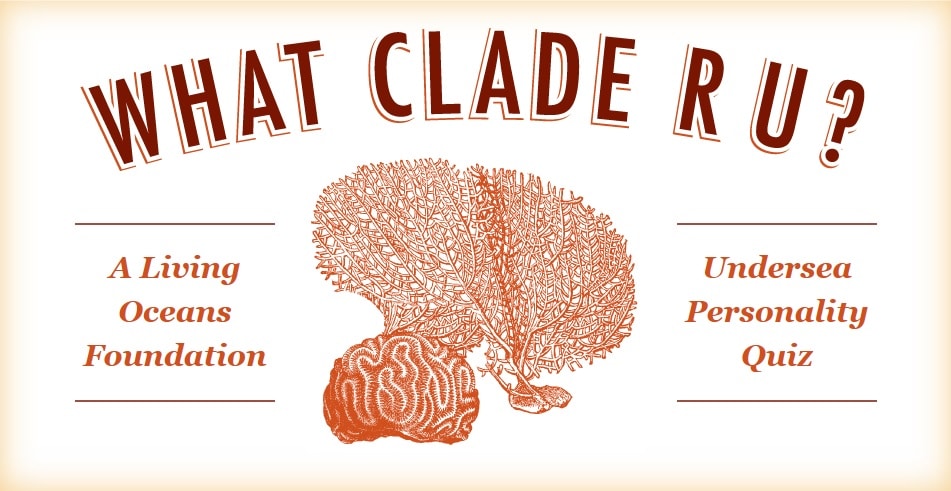
Close X
ATTRIBUTIONS & CITATIONS
ATTRIBUTIONS
Figure 2-6c). By (WT-shared) Seascapeza at wts wikivoyage (This file was imported from Wikivoyage WTS.) [CC-BY-SA-3.0 (http://creativecommons.org/licenses/by-sa/3.0)], 5 May 2012 via Wikimedia Commons. https://commons.wikimedia.org/wiki/File%3ATubular_hydroid_DSF0138.jpg.
Figure 2-12b). I, Jonathan Zander [GFDL (http://www.gnu.org/copyleft/fdl.html), CC-BY-SA-3.0 (http://creativecommons.org/licenses/by-sa/3.0/) or CC-BY-SA-2.5 (http://creativecommons.org/licenses/by-sa/2.5)], 31 July 2007 via Wikimedia Commons. http://commons.wikimedia.org/wiki/File%3AMushroom_Coral_(Fungia)_Top_Macro_91.JPG.
Figure 2-14. By University of California Museum of Paleontology’s Understanding Evolution. http://evolution.berkeley.edu.
Figure 2-15.
a) By Thomas Vandenberghe from Leuven, Belgium (Velociraptor mongoliensis Uploaded by FunkMonk) [CC-BY-SA-2.0 (http://creativecommons.org/licenses/by-sa/2.0)], 5 August 2008 via Wikimedia Commons. https://commons.wikimedia.org/wiki/File%3AVelociraptor_Fighting_Dinosaur.jpg.
b) By H. Raab (User:Vesta) (Own work) [CC-BY-SA-3.0 (http://creativecommons.org/licenses/by-sa/3.0) or GFDL (http://www.gnu.org/copyleft/fdl.html)], 30 October 2009 via Wikimedia Commons. http://commons.wikimedia.org/wiki/File%3AArchaeopteryx_(Feather).jpg.
c) Ballista at the English language Wikipedia [GFDL (http://www.gnu.org/copyleft/fdl.html) or CC-BY-SA-3.0 (http://creativecommons.org/licenses/by-sa/3.0/)], 30 August 2006 via Wikimedia Commons. http://commons.wikimedia.org/wiki/File%3AArchaeopteryx_lithographica.JPG.
Figure 2-16. By University of California Museum of Paleontology’s Understanding Evolution. http://evolution.berkeley.edu.
Figure 2-17. Adapted from University of California Museum of Paleontology’s Understanding Evolution. http://evolution.berkeley.edu.
Figure 2-18. By Alexei Kouprianov (Own work) [GFDL (http://www.gnu.org/copyleft/fdl.html), CC-BY-SA-3.0 (http://creativecommons.org/licenses/by-sa/3.0/) or CC-BY-SA-2.5-2.0-1.0 (http://creativecommons.org/licenses/by-sa/2.5-2.0-1.0)], 4 September 2006 via Wikimedia Commons. http://commons.wikimedia.org/wiki/File%3AIdentical_cladograms.svg.
Figure 2-20. Adapted from University of California Museum of Paleontology’s Understanding Evolution. http://evolution.berkeley.edu.
Figure 2-21. Adapted from University of California Museum of Paleontology’s Understanding Evolution. http://evolution.berkeley.edu.
Figures 2-27 & 2-28. By C.S.Chen National Museum of Marine Biology and Aquarium, Taiwan. http://www.nmmba.gov.tw/english/index.aspx.
CITATIONS
Karako-Lampert, S., Katco, D. J., Achituv, Y., Dubinsky, Z., & Stambler, N. (2004). Do clades of symbiotic dinoflagellates in scleractinian corals of the Gulf of Eilat (Red Sea) differ from those of other coral reefs? Journal of Experimental Marine Biology and Ecology 311: 301-314.
Rodriguez-Lanetty, M., Loh, W., Carter, D., & Hoegh-Guldberg, O. (2001). Latitudinal variability in symbiont specificity within the widespread scleractinian coral Plesiastrea versipora. Marine Biology 138: 1175-1181.





